A quick scan of the eye may offer a simple and painless way for multiple sclerosis patients to track the progress of the disease. Researchers at the Johns Hopkins Multiple Sclerosis Center in Baltimore have discovered that by observing the nerve fibers in the back of the retina, one can get a fairly accurate picture of the decrease in brain volume, a marker of the progression of sclerosis. Multiple sclerosis (MS) is a disease that affects the central nervous system (brain, optic nerves and spinal cord) and is characterized by the destruction of the myelin sheath that insulates nerve fibers (demyelination). Speed and efficiency are compromised: performing harmonious, rapid and coordinated movements becomes increasingly difficult as the disease progresses. The areas where the myelin has been damaged or destroyed are called "plaques" or "lesions", which appear as hardened areas or scars: in multiple sclerosis these scars form at different times and in different areas of the brain and cerebral medulla: from here the name of multiple sclerosis (multiple scars).
You may also like
Diagnosing diabetes from the eye
Researchers at Aston University (Birmingham, UK), are carrying out a unique study of its kind to detect the onset of diabetes early from the eye . The study, in the process of recruiting volunteers, will subject people to a cardiovascular test, a vision and eye pressure test and a blood test. Dr. Doina Gherghel, who… Continua a leggere Diagnosing diabetes from the eye
Dental Implants: Methods, Treatments and focusing on younger patients
Dental implants have revolutionized dental care, offering a potent solution for tooth loss. This article delves into the methods and treatments available, focusing on younger patients, under 55, while exploring new research studies that could redefine dental implantology.
Dental Aligners: Treatment Options for Adults
Dental aligners have revolutionized orthodontics, offering adults a discreet solution to teeth misalignment. This article explores various methods and treatments available, challenges faced by adults, and emerging studies in experimental aligners. Additionally, it delves into regional trends and geographic incidence of treatments.
Dental Implants: Modern Techniques and Emerging Research
Dental implants have revolutionized the field of dentistry, providing patients with robust solutions for replacing missing teeth. This article delves into various methods and treatments available for dental implants, particularly focusing on challenges faced by individuals under the age of 55. Additionally, it explores cutting-edge research and new developments in implant technology, including experimental studies. The piece also examines the geographical distribution and incidence of dental implant procedures globally.
Dental Implants: Transforming Smiles Across Generations
Dental implants have revolutionized the way we approach oral health restoration, offering renewed hope to those suffering from tooth loss. This comprehensive article delves into the methodologies and treatments available, particularly focusing on challenges faced by individuals over 55 years. It also explores cutting-edge research and the geographical incidence of implant procedures globally.
